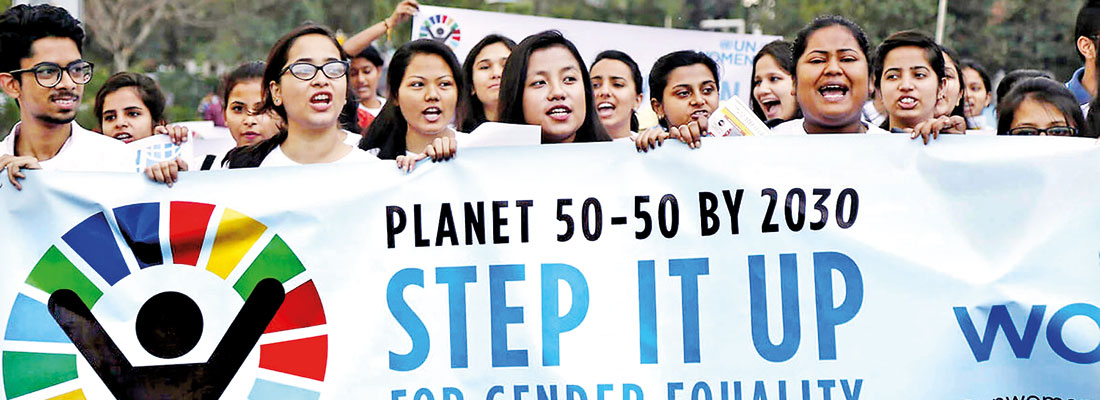Sunday Times 2
After 75 Years, UN claims 50:50 gender parity, but falls short of its ultimate goals

While women have come a long way since the adoption of the Beijing Platform for Action nearly 25 years ago, they still lag behind on virtually every Sustainable Development Goal (SDG). Credit: UN Women, India
UNITED NATIONS (IPS) – When the UN was dominated by men, holding some of the highest positions in the staff hierarchy, the overwhelming majority of women staffers were administrative secretaries pounding on their typewriters seated outside their bosses’ office cubicles with name signs emblazoned outside the door.
A legendary story circulating at the UN for ages recounts the plight of a woman candidate being interviewed for a job. She had superlative credentials, including work experience as a political analyst and was armed with a post-graduate degree from a prestigious Ivy League university in the US.
The male UN staffer from human resources, who interviewed her, had one parting, male-chauvinistic question: “But can you type?”
Mercifully, that was a bygone era. But since then, the UN has made significant progress trying to conform to an age-old General Assembly resolution calling for gender parity system-wide.
As Secretary-General Antonio Guterres tweeted last week: “The #COVID19 pandemic is demonstrating what we all know: millennia of patriarchy have resulted in a male-dominated world with a male-dominated culture which damages everyone – women, men, girls & boys.”
And it also fits in perfectly with the longstanding culture at the United Nations.
As the UN commemorates its 75th anniversary, the world body claims it has achieved 50:50 gender parity in the higher ranks of its administrative hierarchy.
But still falls short of reaching full parity at all levels of the Organisation targeted for 2028 while two recent staff surveys in New York and Geneva raised several lingering questions, including the lack of diversity, the notable absence of women of color system-wide, and the lack of equitable geographical representation of staffers from the developing world.
In a letter to staffers on September 2, Guterres points out the efforts made shortly after he took office: “Nearly four years into this effort, I can report that we have come a long way.”
In 2019, for the first time in United Nations history, he said; “we reached parity in the Senior Management Group and among Resident Coordinators. On January 1, 2020, and well ahead of schedule, we attained this milestone by reaching parity among all full-time senior leaders, comprising 90 women and 90 men at the level of Assistant and Under-Secretaries-General.”
“In addition to the commitment to reach parity and diversify in our senior leadership by 2021, I have committed to achieving parity at all levels of the Organization by 2028”.
“We are on track to meet this target, but progress is uneven and inconsistent. Our greatest challenge is in field missions, where the gap is the largest and the rate of change is slowest”, he added.
Asked for her comments, Prisca Chaoui, Executive Secretary of the 3,500-strong Staff Coordinating Council of the UN Office in Geneva (UNOG), told IPS that in the past, despite the existence of competent women in the UN, it has largely been the reality that when women do achieve career progression, it tends to be mostly women belonging to certain geographical groups or regions.
“There are concerns that implementation of the UN’s Gender Parity Strategy may follow a similar pattern. It is crucial that this important initiative ensures a diverse gender parity that includes women from the global South, women of colour, and women from developing and underrepresented countries,” she noted.
The Organisation can do better at bringing the valuable and creative talents of diverse women together to help bridge the gender gap. This can only help the UN better deliver on its mandate – especially in these challenging times.
“Gender and geographic diversity should not be mutually exclusive. We can implement the Gender Parity Strategy while ensuring improved geographical representation and diversity,” Chaoui declared.
Meanwhile, the lack of geographical diversity is reflected in the absence of staffers from some 21 member states, according to the latest December 2017 figures released in a report to the UN’s Administrative and Budgetary Committee.
The 21 “unrepresented” countries, mostly in the developing world, include Afghanistan, Lao People’s Democratic Republic Saint Lucia, Andorra, Liechtenstein, Saint Vincent and the Grenadines., Angola, Marshall Islands, Sao Tome and Principe, Belize, Monaco, Timor-Leste, Equatorial Guinea, Nauru, Tuvalu, Kiribati, Palau United Arab Emirates, Kuwait, Qatar and Vanuatu.
Ian Richards, former President of the Coordinating Committee of International Staff Unions and Associations, and an economist at the Geneva-based UN Conference on Trade and Development (UNCTAD), told IPS that last year Guterres asked the UN’s member states at the General Assembly to let him change the staff regulations to allow the quotas and promotion and recruitment bans based on gender that he had been seeking for a while. But they refused his request.
“It seems they felt it went against Article 8 of the UN Charter on non-discrimination and Article 101 on merit”.
However, this year, while the pandemic and COVID-19 recovery efforts drew attention elsewhere, it seems he made the changes anyway, albeit through a type of executive order called an administrative instruction, said Richards.
Two questions arise. Is the executive order legal if it contradicts the staff regulations? he asked.
Lawyers have apparently been looking at this. And is it wise to provoke our member states by disregarding their instructions at a time when some are trying to cut our funding? There seems to be some disquiet, he added.
“We all want to advance gender balance and we are all impatient. But I hope our efforts to do so don’t backfire because of this. A further question is why General Service staff weren’t included. They are staff like everyone else and form the backbone of our organization,” asked Richards.

